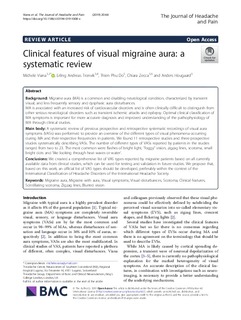| dc.contributor.author | Viana, Michele | |
| dc.contributor.author | Tronvik, Erling Andreas | |
| dc.contributor.author | Do, Thien Phu | |
| dc.contributor.author | Zecca, Chiara | |
| dc.contributor.author | Hougaard, Anders | |
| dc.date.accessioned | 2019-09-24T12:15:24Z | |
| dc.date.available | 2019-09-24T12:15:24Z | |
| dc.date.created | 2019-06-24T12:43:12Z | |
| dc.date.issued | 2019 | |
| dc.identifier.citation | The Journal of Headache and Pain. 2019, 20:64 1-7. | nb_NO |
| dc.identifier.issn | 1129-2369 | |
| dc.identifier.uri | http://hdl.handle.net/11250/2618517 | |
| dc.description.abstract | Background
Migraine aura (MA) is a common and disabling neurological condition, characterized by transient visual, and less frequently sensory and dysphasic aura disturbances.
MA is associated with an increased risk of cardiovascular disorders and is often clinically difficult to distinguish from other serious neurological disorders such as transient ischemic attacks and epilepsy. Optimal clinical classification of MA symptoms is important for more accurate diagnosis and improved understanding of the pathophysiology of MA through clinical studies.
Main body
A systematic review of previous prospective and retrospective systematic recordings of visual aura symptoms (VASs) was performed to provide an overview of the different types of visual phenomena occurring during MA and their respective frequencies in patients. We found 11 retrospective studies and three prospective studies systematically describing VASs. The number of different types of VASs reported by patients in the studies ranged from two to 23. The most common were flashes of bright light, “foggy” vision, zigzag lines, scotoma, small bright dots and ‘like looking through heat waves or water’.
Conclusions
We created a comprehensive list of VAS types reported by migraine patients based on all currently available data from clinical studies, which can be used for testing and validation in future studies. We propose that, based on this work, an official list of VAS types should be developed, preferably within the context of the International Classification of Headache Disorders of the International Headache Society. | nb_NO |
| dc.language.iso | eng | nb_NO |
| dc.publisher | BioMed Central | nb_NO |
| dc.rights | Navngivelse 4.0 Internasjonal | * |
| dc.rights.uri | http://creativecommons.org/licenses/by/4.0/deed.no | * |
| dc.title | Clinical features of visual migraine aura: A systematic review | nb_NO |
| dc.type | Journal article | nb_NO |
| dc.type | Peer reviewed | nb_NO |
| dc.description.version | publishedVersion | nb_NO |
| dc.source.pagenumber | 1-7 | nb_NO |
| dc.source.volume | 20:64 | nb_NO |
| dc.source.journal | The Journal of Headache and Pain | nb_NO |
| dc.identifier.doi | 10.1186/s10194-019-1008-x | |
| dc.identifier.cristin | 1707234 | |
| dc.description.localcode | Open Access This article is distributed under the terms of the Creative Commons Attribution 4.0 International License (http://creativecommons.org/licenses/by/4.0/), which permits unrestricted use, distribution, and reproduction in any medium, provided you give appropriate credit to the original author(s) and the source, provide a link to the Creative Commons license, and indicate if changes were made. | nb_NO |
| cristin.unitcode | 1920,16,1,0 | |
| cristin.unitcode | 194,65,30,0 | |
| cristin.unitname | Nasjonal kompetansetjeneste for hodepine | |
| cristin.unitname | Institutt for nevromedisin og bevegelsesvitenskap | |
| cristin.ispublished | true | |
| cristin.fulltext | original | |
| cristin.qualitycode | 1 | |

